#Projection Studio
Explore tagged Tumblr posts
Text
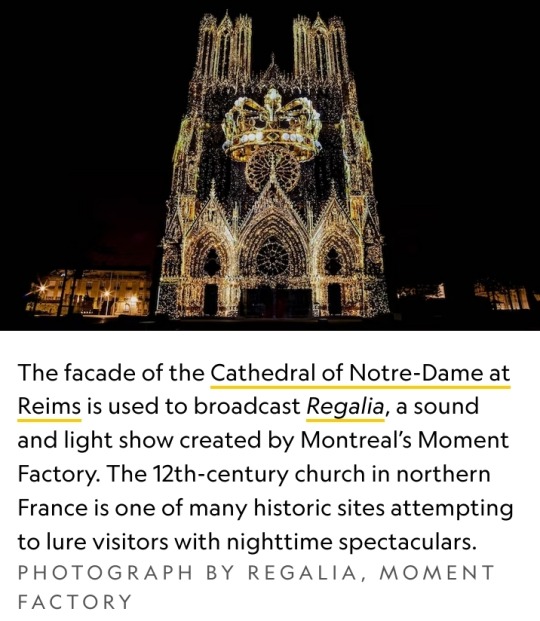
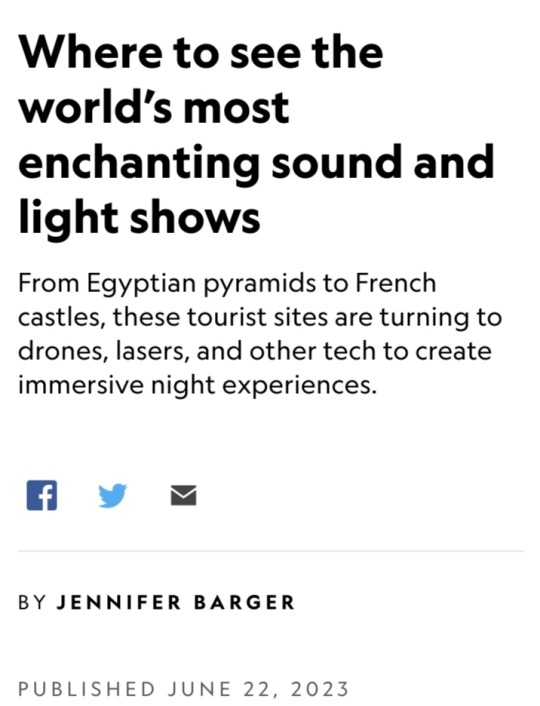
More than two miles long and 1,142 feet tall, Uluru, the red sandstone rock formation in Australia’s Northern Territory, wows travelers during the day.
But now, a new night spectacle Wintjiri Wiru illuminates the darkness adjacent to the monolith in a way that reveals Indigenous culture while dazzling with high-tech sound and lights.
“Humans are drawn to light—just think of how compelling sunsets are,” says Melbourne light artist Bruce Ramus, who designed the work in collaboration with the local Anangu people and Voyages Indigenous Tourism.
Wintjiri Wiru is just the latest offering—and newest technology — in the tradition of son et lumière (sound and light) shows, grand public spectacles projected on to (or close to) historic buildings and natural wonders.
These mash-ups of pageantry, culture, and art are experiencing a boom fueled by digital advances and tourist sites looking to attract visitors after dark.
Here’s where to see the latest shows, plus why visitors love these “virtual campfires.”

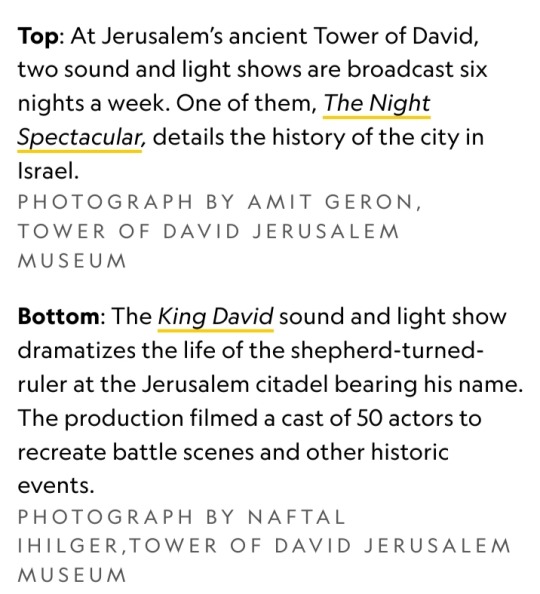
How did sound and light shows start?
Paul Robert-Houdin created the first sound and light show in 1952 at France’s Château de Chambord.
Music and narration played while slide projectors splashed colored lights on the 16th-century palace.
“We had the feeling that a new way of discovering and understanding monumental heritage was perhaps being born,” one observer wrote in Le Figaro newspaper.
The concept was a hit.
“Standing in the dark and being immersed in sounds and images creates a sense of enchantment,” says Jane Lovell, a professor of tourism at Canterbury Christ Church University in England.
In the following decades, other storied sites harnessed that magic, such as the Red Fort in Delhi, India, and Independence Hall in Philadelphia.
“There were captive audiences for these attractions, so the efforts were minimal—just light up these beautiful things that already existed,” says California light show producer Ryan Miziker.
Early technology was expensive and bulky: sofa-sized slide carousels, finicky stereo speakers that malfunctioned in bad weather.
The storytelling, if mostly historically accurate, could be clunky and lecturing.
At Egypt’s Pyramids at Giza, the still-running circa-1961 show features the Sphinx “narrating” a lofty spiel about ancient life as murky colored lights wash over the monuments.
youtube
https://youtu.be/anLYLqMyK1I
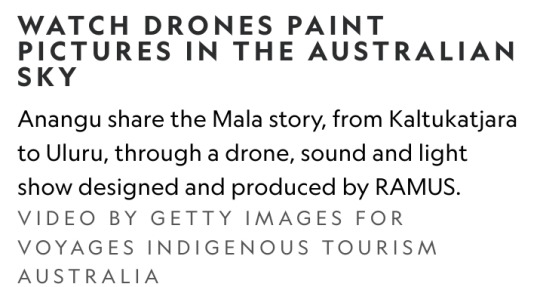
How tech took over light shows
“Son et lumieres started out as pretty rudimentary things—a castle would be lit up and a soundtrack would say, ‘this tower was built in 1592,’” says Ross Ashton of London’s Projection Studio, which designs extravaganzas for attractions from Welsh castles to Indian fortresses.
But by the 1990s, innovations in video, lasers, and audio meant creators could screen riveting, mind-bending shows.
“Digital video changed everything,” says Miziker.
“We had software to do 3-D mapping, which takes a round object like a globe and flattens it, or wraps any structure in overlapping, blending geometry.”
Sound evolved, too.
“Bells, spoken voices from different directions, or a fireball rolling, you can layer sound up, so it feels like a tapestry,” says Projection Studio’s sound artist Karen Monid.
Today’s sound and light shows are like mini action movies screened on historic buildings or natural wonders.
San Antonio’s The Saga wraps the 18th-century San Fernando Cathedral in sound effects (mariachi ballads, cannon blasts) and painterly images (folk dancers, renderings of the Alamo) to tell the story of the Texas city.
In Jerusalem, Israel, the ancient Tower of David has two night shows, one on city history and the other about the biblical shepherd-turned-ruler that gave the site its name.
Wintjiri Wiru harnesses LED lights, lasers, sound, and 1,100 drones to recount a legend from the Anangu, who consider Uluru sacred.
The show depicts mala (wallaby-rabbit) beings battling a gigantic devil dog spirit.
“Combine light with sound—in this case Anangu songs and other effects—and it’s like the desert is speaking,” says Ramus.
Other projects are more abstract, such as the new Aura Invalides show at Les Invalides in Paris, which fills the grand interiors of the historic military monument with surreal rays of colored light and outlines architectural elements in laser graffiti.
“People move around within the building, making it more like a 360-degree immersion than something didactical,” says Manon McHugh, a spokesperson for Moment Factory, the studio that created the show.
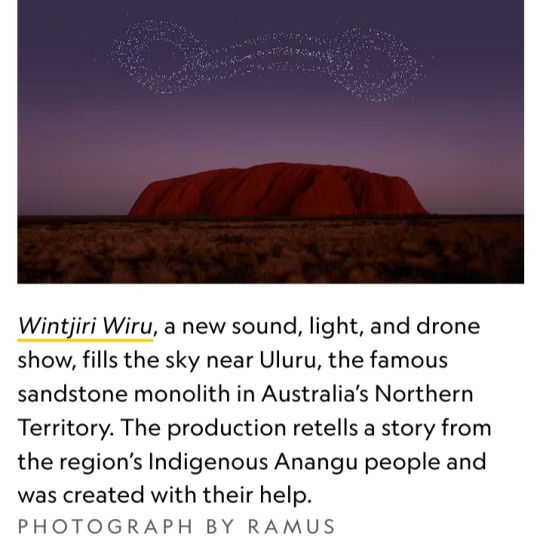
Why travelers love spectacles
Experts think people are drawn to these shows for their sense of wonder and spectacle.
“Sound and light shows are like fireworks—it’s impossible to look away,” says Miziker.
"Since audiences are sitting in the dark, there’s cognitive dissonance, with the atmosphere almost becoming its own entity,” says Lovell.
youtube

https://youtu.be/FV3XdOda3zM
Plus, in this age of Instagram, sound and light spectacles make ideal selfie backdrops or video ops.
“When Moment Factory started doing shows, we didn’t want people to have their phones out,” says McHugh.
Now, other digital production studios build in elements like photo booths to encourage participants to share their experiences.

How sound and light shows help tourist sites
Sound and light shows can be expensive and time-consuming to design.
(Wintjiri Wiru was developed over several years and cost $10 million.)
But many tourist attractions and cities are willing to shell out.
“They produce new income streams,” says Ashton. “People normally go home at night, but if you sell them a ticket to an illumination, they’ll come back.”
Many sound and light experiences in public, urban spaces — outside cathedrals, on city halls, across skyscrapers — are free, but paid for by cities to give visitors an excuse to stay an extra night.
“We used to think of tourism as a daytime activity, but there has been this tourist-ification of the night,” says Andrew Smith, a professor of urban experiences at England’s University of Westminster.
“Now cities want to attract people and keep them in town. It’s a commodification of the night, a way to extend economic and cultural activity.”
Studies indicate that these shows might even make city downtowns feel safer. “It starts to dematerialize the buildings,” says Ramus.
“You just see the lights, and our cities become transparent. They feel gentler.”
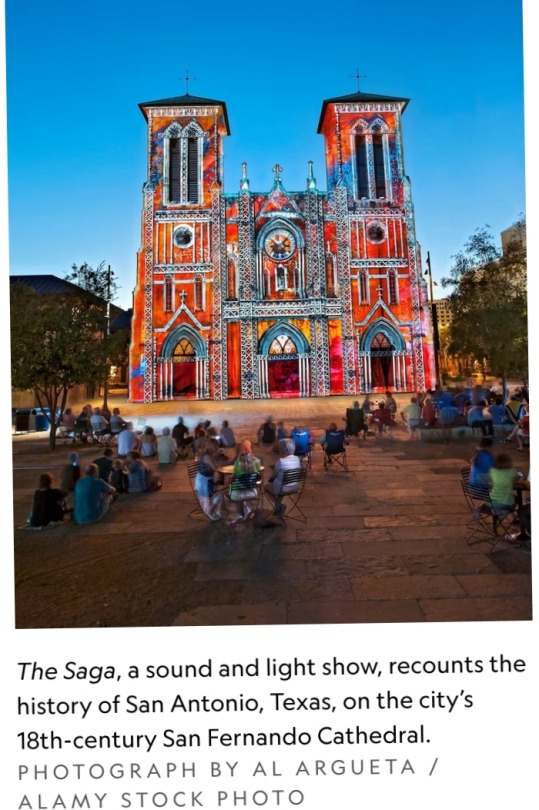
#Youtube#Wintjiri Wiru#son et lumière#sound and light shows#Paul Robert-Houdin#Château de Chambord#France#Pyramids at Giza#Cathedral of Notre-Dame#Regalia#Moment Factory#Uluru#Anangu people#Voyages Indigenous Tourism#The Night Spectacular#King David#Jerusalem#Projection Studio#San Fernando Cathedral#Tower of David#LED lights#drones#sound#lasers#Aura Invalides#National Geographic#Nat Geo#The Saga
5 notes
·
View notes
Text






Collected Work In Progress pics from The Studio Project.
Really proud of this double cabinet/drawers arrangement. Everything is bolted to the walls for safety, there's braces between the cabinets and drawers and that gap lets me reach the Outlet.
Special thanks to @xiaq and @hellenhighwater for sharing their kickass house projects and giving me the initiative to do mine.
#home improvement#studio project#House of Another Color#<going to make that my home improvement projects tag
5K notes
·
View notes
Text
"Go to hell" is basic. "Hope your favourite anime movie sequel gets cancelled after seven years in production AND getting an animated teaser." is smart. It's possible. It's terrifying. It's happened.
#I don't follow YOI#but seriously though I feel really bad for the fans#Mappa has such talented staff but management's work practices suuuuuck#those guys are probably being overworked on way too many projects and there's been too high a staff turnover to continue the film#like I'd be amazed if any of the original artists are still working on it#imagine working on it knowing now that your work won't see daylight and that none of the overtime or suffering was worth it#yuri on ice#ice adolescence#mappa studio
11K notes
·
View notes
Text





🐎Today's Miku figure is:🐎
Pink Kitty Studio Xuanzhuan Muma garage kit ver. (2024)
#hatsune miku#vocaloid#vocal synth#project diva#vocaloid miku#anime figures#anime figure#garage kit#pink kitty studio#daily figure
3K notes
·
View notes
Text

new pokemon protagonists real⁉️⁉️⁉️
#hatsune miku#vocaloid#piapro studio#doodle#kasane teto#utau#synthv#pokemon#project voltage#meleotta#yeah the official teto design caught me off guard too#thank you crypton for reviving project voltage just for Teto Day
1K notes
·
View notes
Text
doing screenshot saturday for the first time, calling variables in dialogue is going great!

3K notes
·
View notes
Text

I AM A SINNER, YOU ARE A SAINT.
#my art#project edens garden#damon maitsu#diana venicia#fanart#artists on tumblr#digital artist#diamon#(it wasn't made to be diamon to be exact. ppl think it's diamon on twitter so who am i to say no to that.)#clip studio paint
2K notes
·
View notes
Text

pathologic 3 announcement made me return to the classic game and finally play it properly! i think my favorite part of the bachelor's route is when he talks to maria kaina (or whoever's in her body at the time) and they explain that their planned Utopia isn’t even supposed to be a 'perfect' place but instead 'the mystical manifestation of a world inscrutable and inaccessible to men' going back to the original meaning of the word irl and instead of despairing Daniil fervently agrees that this kind of unimaginable leap is worth it, no matter where it actually leads
#pathologic#the bachelor#daniil dankovsky#andrey stamatin#peter stamatin#maria kaina#nina kaina#recent interview with dybowski made me kind of apprehensive#because i love the idea of an emotional state as a fundamental game mechanic for the bachelor but#he was very focused on the idea of following the 'teacher' in Simon and in the process learning everything he was meant to learn#despite never really 'catching' the dead guy in his time loops#i feel that the head of the studio is just projecting again#and in a way that old version of the bachelor made back when he was a student in his twenties#could end up seeming more compelling in the end#but we'll SEE#i am still wildly hopeful and hype#my artwork#ALSO anybody who likes the bachelor and reads those rambling tags#you should totally check out blank monk by chekhov#its short
1K notes
·
View notes
Text
hi tumblr have kanpai funk but pjeg
#project eden's garden#p:eg#pjeg#pjeg fanart#damon maitsu#eva tsunaka#wolfgang akire#diana venicia#kai monteago#clip studio kept deleting frames omg
1K notes
·
View notes
Text
I present to you, ROTTMNT Soundtrack's first track...

youtube
○○○○

YOUTUBE 💜💜💜💜💜💜💜💜💜💜💜💜💜💜💜💜💜 KOFI
#Oh- and this is an ongoing project!#So if you have any suggestions for Rise songs you want the full versions to - I'm all ears! 😁#RiseStarKiss Studios#Rise Reprise Project#ROTTMNT OST#Rise of the TMNT Soundtrack#Rise of the TMNT OST#Rise of the Teenage Mutant Ninja Turtles Soundtrack#rottmnt#tmnt#teenage mutant ninja turtles#rise of the teenage mutant ninja turtles#rise of the tmnt#tmnt2018#tmnt 2k18#tmnt 2018#save rottmnt#unpause rottmnt#unpause rise of the tmnt#save rise of the tmnt#save rise of the teenage mutant ninja turtles#The Clothes Don't Make The Turtle#YOU GOT THE GOODS
752 notes
·
View notes
Text

*guilt-frees your kanade*
#prsk fa#prsk art#nightcord at 25:00#project sekai#vocaloid#digital painting#fanart#digital art#artists on tumblr#clip studio paint#kanade yoisaki#kanade pjsk#niigo kanade#proseka
2K notes
·
View notes
Text



Project Voltage cannot drop a Cynthia Banger and not expect me to respond!!

#clip studio paint#scraggscribbs#pokemon#digital illustration#volo#pokemon legends arceus#giratina#togekiss#hatsune miku#cynthia#project voltage#pokemonfanart#fanart
2K notes
·
View notes
Text
Seabirds of the Artechocene:
The Anthropogenic Extinction Event was particularly devastating for ocean ecosystems, including the seabirds that relied on it, with only a few species surviving the event. 39 million years later however, life has recovered, and now the descendants of these seabirds, as well as other aquatic birds that took to the seas, are a common sight worldwide, belonging to a variety of different groups:


Full piece of the seabird diversity in the Artechocene oceans
•Vesselbirds (Caravelorniformes):
A widespread group of the largest of the Artechocene seabirds, they have abandoned land completely, brooding being taken care of by a specialised structure on the male's back that acts as a nest.
•Corsairfishers (Piratosagipterines):
Kingfishers relatives that use kleptoparasitism as one of their main feeding strategies, often following larger, more specialised seabirds.

Close-up on the vesselbirds and corsairfishers
•Kitegulls (Milvulari):
Close relatives of cacklers, they are long distance flyers, feeding on surface prey and rarely landing, only to breed on isolated islands across their expansive range in temperate and tropical oceans worldwide.
•Sea Songbirds (Thalassopasseridae):
A unique family of passeriformes found mostly around the southern hemisphere, the scallywags (Pelagopasser sp.) are a genus of open ocean specialists that are found on every ocean except the Arctic, flapping and skimming the surface of the ocean to feed on small planktonic prey.
•Dumingos (Anabalaenidae):
A cosmopolitan group of filter feeding ducks, they are typically found in inland waters, but a few species, like the sea dumingo (Pinnatocetus celer), have been able to exploit its endless amount of plankton.
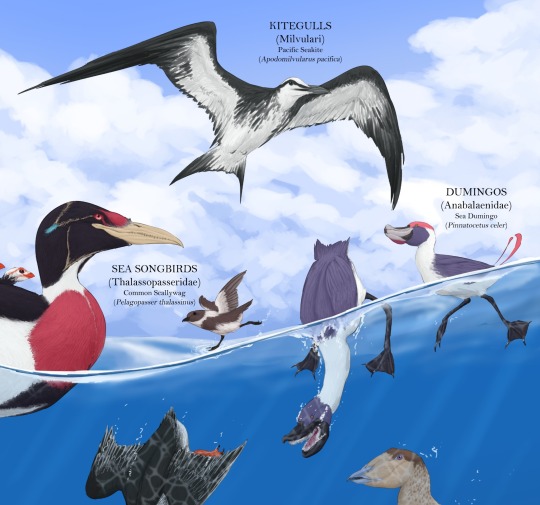
Close-up on the sea songbirds, dumingos and kitegulls
•Harpansers (Dinomergidae):
Found mostly around the northern hemisphere, these sea ducks are specialised fish eaters that can dive and swim particularly well. Hunting in large groups, they can co-ordinate to hunt down entire schools of fish and squid.
•Seadrakes (Thescelodyptidae):
A family of very diverse, cosmopolitan sea ducks found mostly in cold oceans, that are characterised by their colorful males and hardened papillae inside of of their mouths, specialised for each species' diet. The star-horned squobbler (Magnificodyptes asterotops) in particular is a squid specialist, using hooked papillae and suction to keep its soft bodied prey from escaping.
•Umibozulles (Bathostyxiformes):
A unique offshoot of the full clade native to the Pacific, Arctic and north Atlantic regions, these fully nocturnal seabirds are extremely cryptic and hard to see, leaving their colonies in the middle of the night to dive and incredible depths in search of small invertebrates and fish; using their black, iridescent feathers that appear pitch dark at depth, to go unnoticed by prey.
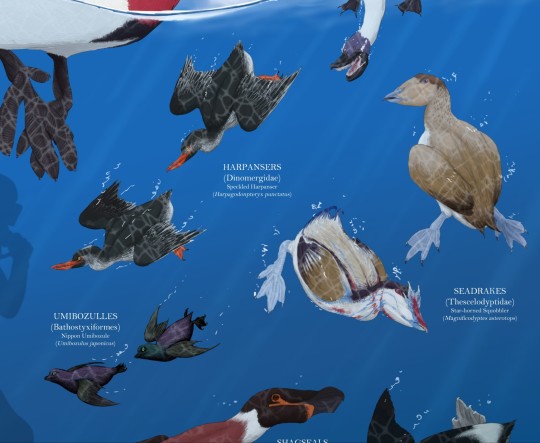
Close-up on the harpansers, seadrakes and umibozulles
•Shagseals (Phociornithiformes):
A flightless order of the cormorant clade, they include the largest seabirds of the Artechocene. This is due to their dense bones, which they use alongside their sensitive beaks to swim hovering just above the seafloor at great depth, coming out to breathe every few hours, thanks to a very efficient circulatory system. Despite being mostly aquatic, to breed they must come out to land, where males use a specialised armpit pouch to brood the eggs and young.
•Balamars (Balaornithidae):
Another cosmopolitan member of the gull clade, they are adapted for speed, being able to plunge dive and pursue prey at incredible velocity.
•Penmorants (Pinguriliiformes):
Another order of flightless seabirds in the cormorant clade, these are much more widespread and pelagic, being able to be spotted in the open ocean in every region, but with the highest diversity being in the northern hemisphere. Unlike vessel birds, these need to come back to land to breed.
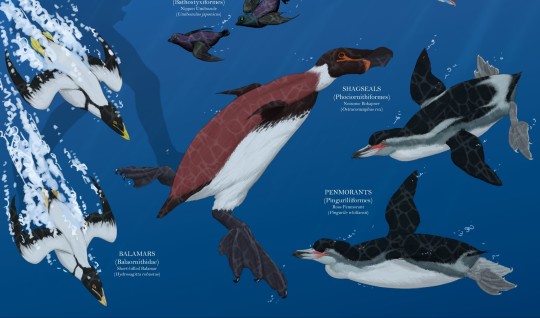
Close-up on the balamars, shagseals and penmorants
•Coast Cacklers (Neolaridae):
A living fossil amongst the full clade, they're generalist predators found in coasts and open seas all across the world, from pole to pole.
•Titan Gulls (Laroposeidonidae):
The largest of the flying seabirds, these long distance flyers can be found on the open ocean across the southern hemisphere and the Pacific Ocean.
•Kelp Ruddies (Phycophaganatidae):
Specialised algae grazing ducks distributed along the cold coasts of every continent except Africa.
•Labrosone Geese (Auloceratidae):
Anseriforms with a uniquely complex nasal structure that amplify and warp their calls, some marine species can be found along the coasts of Afro-Eurasia.
•Windtellers (Aequoelanus sp.):
A small genus of medium sized predators that can be found offshore of coastal forests across the world, lunging on fish too close to the surface.
•Basketgulls (Pelecanoidae):
Another, very voracious, relative of cacklers, found offshore on every ocean except for the arctic. Good flyers, they usually plunge into the water to catch shoals of small prey.

Close-up on the coast cacklers, kelp ruddies, labrosone geese, windtellers and basketgulls
•Bagshags (Euryrhamphinae):
A diving predator capable of gulping down fish larger than itself, these voracious, near flightless birds can be found in coasts and freshwater systems of the tropics and temperate areas of the world.
•Taornes (Hastanhinga sp.):
A pantropical genus highly associated with clamoral reefs and other high diversity, shallow water ecosystems, slowly stalking prey hidden in crevices or substrate with pinpoint precision.
•Seahens (Littogallidae):
Omnivores found in areas not far from the coast of every continent. They are diverse and occupy a wide variety of niches, specialising on different diets depending on the available resources.
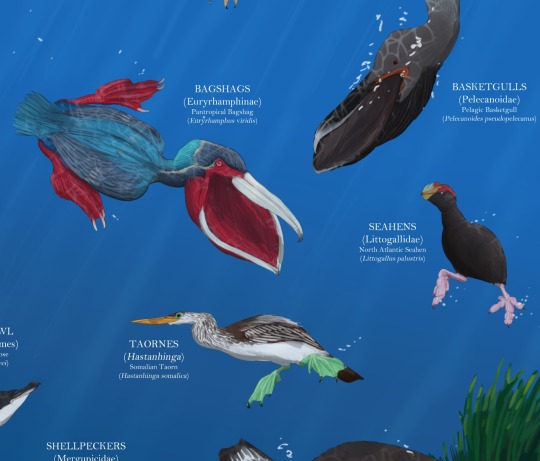
Close-up on the bagshags, taornes and seahens
•Wakageese (Wakaereformes):
A basal offshoot of the waterfowl clade, it has evolved a unique style of swimming and very specialised, hydrodynamic feathering. It evolved isolated on Antarctica soon after it started to thaw, and is now distributed mostly around the southern ocean.
•Shellpeckers (Mergupicidae):
One of the few non-gull marine charadriiformes left, these have taken a rather unique approach to a durophagous diet, using a strong beak and a hammering motion to open the shellfish it dives for.
•Anatorants (Sulanatidae):
A flying, basal offshoot of the phociornithiformes, presenting a similar beak sensitivity as their relatives but less aquatic specialisations. Given their flight capabilities, they're found much more widespread than their northern relatives, extending far into the southern hemisphere.

Close-up on the wakafowl, shellpeckers and anatorants
•Mergeese (Sirenianseridae):
Aquatic grazers very specialised for their lifestyle, with a large crop that is used for fermenting the plant material. Because of this diet, they're highly associated with seagrass meadows in the Indo-Pacific, Caribbean and European regions.
•Sandabblers (Psammobenthavinae):
A cosmopolitan anatid subfamily of diving soft sediment specialists that can be found in both fresh and saltwater ecosystems, but the majority are often associated with soft sediment ocean shores.

Close-up on the mergeese and sandabblers
Hope you liked this compilation of Artechocene seabird diversity!!
#art#my art#The Artechocene Project#illustration#clip studio paint#speculative evolution#speculative biology#creature design#birds#spec evo#seabird#penguin#cormorant#seagull#pelican
518 notes
·
View notes
Text
me when its tmagp episode three already and theres still no 140k words gwen bouchard x alice dyer slowburn hurt/comfort trying to murder each other falling in love instead: 🤯

#their ship name… its dyhard…..#dyhard#alice dyer#gwen bouchard#the magnus protocol#tmagp#art#fanart#clip studio paint#my art :)#i did this instead of working on my semestral project and now i might not make it in time:3#this file is saved as oh i love you girls i love you i love you.jpg
3K notes
·
View notes
Text

stars
1K notes
·
View notes